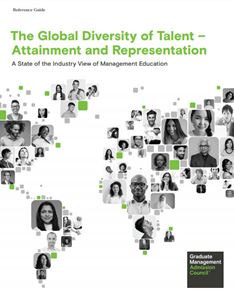Since GME is global, the elements comprising a diverse classroom – gender, race, socio-economic background, and national origin, among others – may be prioritized differently in different regions. However, if we are to make gains in educating student bodies that reflect the communities we serve, we must first understand where we are today.
GME is global, the elements comprising a diverse classroom – gender, race, socio-economic background, and national origin, among others – may be prioritized differently in different regions. However, if we are to make gains in educating student bodies that reflect the communities we serve, we must first understand where we are today.
How diverse is Graduate Management Education (GME) compared to our community (demographics) and the potential pipeline (undergraduate degrees granted)? Where do we excel and where do we have work to do?
This new resource by GMAC, The Global Diversity of Talent – Attainment and Representation, is the first state of the industry view about diversity in graduate management education. This reference guide provides a framework to understand diversity in the GME pipeline today in order to positively influence the business school classrooms of tomorrow.
The main report – The Global Diversity of Talent – Attainment and Representation: A State of the Industry View of Management Education – provides a global overview, seven regional outlooks, and separate reports for 69 locations or countries with an estimated 25,000 or more people within the student-aged population of 20 to 34 who have attained a master’s degree in the subject of business administration, or law. all sourced from 2017-18 data set. Additionally, a feature is included for data on women worldwide as well as segments for data displayed by United States race/ethnicity. Considering the latest available data for global consistency, 2018 data is the base year that draws from across the US Census Bureau International Database, The World Bank, UNESCO, UNECE, and OECD.
While the main report highlights the largest 69 sources of degree-holders for the talent pipeline (25,000 or more), The Global Diversity of Talent – Attainment and Representation Supplemental Report, Appendix 3, offers an alphabetized list of the entire set of 175 reports available for countries or locations with an estimated 600 or more people within the student-aged population of 20 to 34 who are assumed to have attained a master’s degree in the subject of business, administration, or law, all sourced from 2017-18 data set.
These reports can assist with goals toward greater classroom diversity in the following ways:
- Understanding access and representation in the pipeline to business master’s degrees,
- Gauging the willingness to study business among key talent segments, and
- Measuring attainment based on study subject and level of degree